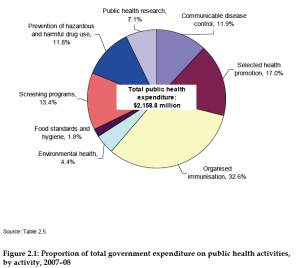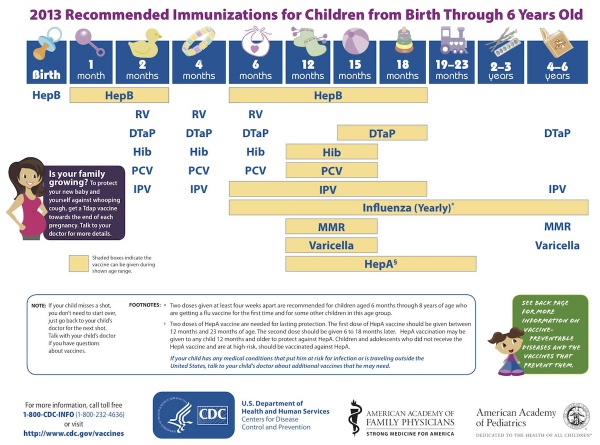Postnatal - Vaccination: Difference between revisions
mNo edit summary |
mNo edit summary |
||
| Line 50: | Line 50: | ||
==Australian Immunisation Handbook== | ==Australian Immunisation Handbook== | ||
[[File:Aus-Imm-Handbook-2015.jpg|thumb|alt=Australian Immunisation Handbook|Australian Immunisation Handbook (2015) | [[File:Aus-Imm-Handbook-2015.jpg|thumb|alt=Australian Immunisation Handbook|Australian Immunisation Handbook (2015)]] | ||
The purpose of The Australian Immunisation Handbook<ref name=AIH2015>{{Ref-Australian Immunisation Handbook2015}}</ref> is to provide clinical guidelines for health professionals on the safest and most effective use of vaccines in their practice. These recommendations are developed by the Australian Technical Advisory Group on Immunisation (ATAGI) and endorsed by the National Health and Medical Research Council (NHMRC). | The purpose of The Australian Immunisation Handbook<ref name=AIH2015>{{Ref-Australian Immunisation Handbook2015}}</ref> is to provide clinical guidelines for health professionals on the safest and most effective use of vaccines in their practice. These recommendations are developed by the Australian Technical Advisory Group on Immunisation (ATAGI) and endorsed by the National Health and Medical Research Council (NHMRC). | ||
Revision as of 09:39, 12 March 2018
| Embryology - 16 Apr 2024 |
|---|
| Google Translate - select your language from the list shown below (this will open a new external page) |
|
العربية | català | 中文 | 中國傳統的 | français | Deutsche | עִברִית | हिंदी | bahasa Indonesia | italiano | 日本語 | 한국어 | မြန်မာ | Pilipino | Polskie | português | ਪੰਜਾਬੀ ਦੇ | Română | русский | Español | Swahili | Svensk | ไทย | Türkçe | اردو | ייִדיש | Tiếng Việt These external translations are automated and may not be accurate. (More? About Translations) |
| Educational Use Only - Embryology is an educational resource for learning concepts in embryological development, no clinical information is provided and content should not be used for any other purpose. |
Introduction
Although the use of most vaccines during pregnancy is not usually recommended on precautionary grounds, there is no convincing evidence that pregnancy should be an absolute contraindication to the use of any vaccine, particularly inactivated vaccines. The only exception is vaccinia virus (smallpox vaccination), which has been shown to cause fetal malformation. For Australian information see the Australian Immunisation Handbook (June2015)[1]
- AIH 10th edition 3.3.2 - Women planning pregnancy "The need for vaccination, particularly for hepatitis B, measles, mumps, rubella and varicella, should be assessed as part of any pre-conception health check. Where previous vaccination history or infection is uncertain, relevant serological testing can be undertaken to ascertain immunity to hepatitis B, measles, mumps and rubella."
Tinycc Vaccination page - http://tiny.cc/Vaccination
Some Recent Findings
|
| More recent papers |
|---|
|
This table allows an automated computer search of the external PubMed database using the listed "Search term" text link.
More? References | Discussion Page | Journal Searches | 2019 References | 2020 References Search term: Vaccination Postnatal Vaccination <pubmed limit=5>Postnatal Vaccination</pubmed> |
Neonatal Vaccination
Vaccination of premature infants
A recent study has looked at Wheezing lower respiratory disease hazard ratios (HR) for vaccination of premature infants.[4] Premature infants are at increased risk of wheezing in association with respiratory syncytial virus (RSV) and rhinovirus infections. The study found no evidence of increased WLRD risk following routine vaccinations of premature infants. WLRD risk among non-fragile premature infants appears to be reduced for a few weeks after live attenuated vaccinations.
- "Wheezing lower respiratory disease hazard ratios (HR) were not significantly elevated for any vaccine type among non-fragile or fragile premature infants. Among non-fragile infants the 8-14 days HR was significantly reduced for live attenuated MMR (0.68, 0.52-0.88) and Varicella (0.71, 0.53-0.94) vaccines, and similarly but insignificantly reduced for infrequently used live attenuated OPV vaccine (0.70, 0.46-1.06). There was a smaller significant reduction (0.83, 0.69-0.998) in the 15-30 days HR for MMR and a similar but not significant reduction (0.86, 0.71-1.05) in the 31-44 days HR for MMR. Hepatitis B vaccine (HBV), which is not a live vaccine, had significantly reduced 8-14 days (0.84, 0.72-0.98) and 31-44 days (0.88, 0.78-0.98) HRs among non-fragile infants. The apparent protective effect of HBV may be confounded by live vaccines administered simultaneously with the third dose of HBV. Among fragile infants there was a large significant reduction in the 8-14 days HR for live attenuated OPV vaccine (0.40, 0.23-0.70) and smaller significant reductions in the 8-14 days HR for inactivated DTaP (0.82, 0.71-0.95), Hib (0.83, 0.73-0.96), and PCV7 (0.84, 0.70-0.997) vaccines. Delays in vaccinating fragile infants may have made simultaneous administration of live vaccines and third doses of these inactivated vaccines more likely."
Australian Immunisation Handbook
The purpose of The Australian Immunisation Handbook[5] is to provide clinical guidelines for health professionals on the safest and most effective use of vaccines in their practice. These recommendations are developed by the Australian Technical Advisory Group on Immunisation (ATAGI) and endorsed by the National Health and Medical Research Council (NHMRC).
There is a specific section within the handbook for Vaccination of women planning pregnancy, pregnant or breastfeeding women, and preterm infants.
- Links: AIH 10th edition (June 2015) | V3.3.2 Vaccination of women who are planning pregnancy, pregnant or breastfeeding, and preterm infants (June 2015) | AIH 9th edition (2008)
| Australian Child Immunisation Programs 2013 | |
|---|---|
| Age | Vaccine |
| Birth |
|
| 2 months |
|
| 4 months |
|
| 6 months |
|
| 12 months |
|
| 18 months |
|
| 4 years |
|
| Notes: | Information provided for educational purposes only. Postnatal - Vaccination | Immunise Australia Program
a Hepatitis B vaccine: should be given to all infants as soon as practicable after birth. The greatest benefit is if given within 24 hours, and must be given within 7 days. b Rotavirus vaccine: third dose of vaccine is dependent on vaccine brand used. |
| Source: | Australian Immunisation Handbook 10th edition (April 2013).[1] National Immunisation Program Schedule From 1 February 2013 to 30 June 2013 PDF Immunise Australia Program. |
NSW
There have been significant changes to the vaccines offered in the NSW vaccination program over time:
- 1988, NSW conducted a Bicentennial measles campaign which offered measles vaccine to all child care and primary school age children.
- 1998 the national Measles Control Campaign, which was the first national mass vaccination program since the 1950s polio campaigns, offered measles, mumps, rubella vaccine to all primary school children laying the groundwork that has resulted in the World Health Organization declaration of measles elimination in Australia
- 2003 the meningococcal C vaccine was offered to all 1 – 19 year olds over a two year period
- 2004 a hepatitis B vaccine catch up program was conducted for Year 7 students who had not received a primary course of vaccine and continued until 2013.
- 2007 the three-dose course of human papillomavirus (HPV) vaccine was offered to female students in Years 10-12 . In 2008 it was offered to female students in Years 7 – 10, and routinely to female students in Year 7 from 2009 and was introduced routinely for male students in Year 7 in 2013 with a catch-up program for male students in Year 9 in 2013 and 2014 only
- booster dose of diphtheria-tetanus-pertussis (dTpa) vaccine was offered to students in Years 7-12 in 2004, in Year 7 in 2005, in Year 10 from 2009-2012 and has been routinely offered to students in Year 7 from 2010 onwards
- catch-up dose of varicella (chicken pox) vaccine has been offered to students in Year 7 since 2006
(From NSW Health - Communicable Diseases)
USA Recommended Immunizations for Children
(Birth through 6 years)
- Links: Vaccines | Advisory Committee on Immunization Practices (ACIP) Recommended Immunization Schedule for Persons Aged 0 Through 18 Years — United States, 2013
References
- ↑ 1.0 1.1 Australian Immunisation Handbook [ AIH 10th edition (June 2015) Cite error: Invalid
<ref>tag; name 'AIH10' defined multiple times with different content - ↑ <pubmed>23262941</pubmed>
- ↑ <pubmed>23381200</pubmed>
- ↑ <pubmed>21875634</pubmed>
- ↑ The Australian Immunisation Handbook 10th edition (2015) Canberra: Australian Government Department of Health. ISBN: 978-1-74241-861-2 Online ISBN: 978-1-74241-862-9.
Journals
Vaccine is the journal for those interested in vaccines and vaccination. Homepage | PubMed
Reviews
<pubmed></pubmed> <pubmed></pubmed> <pubmed>21571717</pubmed> <pubmed>18622208</pubmed>
Articles
<pubmed></pubmed> PMID 23364302 | MMWR Recomm Rep. <pubmed>21658665</pubmed>
External Links
External Links Notice - The dynamic nature of the internet may mean that some of these listed links may no longer function. If the link no longer works search the web with the link text or name. Links to any external commercial sites are provided for information purposes only and should never be considered an endorsement. UNSW Embryology is provided as an educational resource with no clinical information or commercial affiliation.
Australia
- Department of Health and Ageing Immunise Australia Program The Immunise Australia Program aims to increase national immunisation rates by funding free vaccination programs, administering the Australian Childhood Immunisation register and communicating information about immunisation to the general public and health professionals.
- Australian Immunisation Handbook. 9th edition (2008) | AIH 10th edition (April 2013)
- 2.3 Groups with Special Vaccination Requirements updated July 2009
Canada
United Kingdom
- Department of Health Immunisation information | Green Book and Vaccine Update
- Joint Committee on Vaccination and Immunisation
USA
- CDC Vaccines | Immunization Schedules | Possible Side-effects from Vaccines | Advisory Committee on Immunization Practices | Advisory Committee on Immunization Practices (ACIP) Recommended Immunization Schedule for Persons Aged 0 Through 18 Years — United States, 2013
Glossary Links
- Glossary: A | B | C | D | E | F | G | H | I | J | K | L | M | N | O | P | Q | R | S | T | U | V | W | X | Y | Z | Numbers | Symbols | Term Link
Cite this page: Hill, M.A. (2024, April 16) Embryology Postnatal - Vaccination. Retrieved from https://embryology.med.unsw.edu.au/embryology/index.php/Postnatal_-_Vaccination
- © Dr Mark Hill 2024, UNSW Embryology ISBN: 978 0 7334 2609 4 - UNSW CRICOS Provider Code No. 00098G




